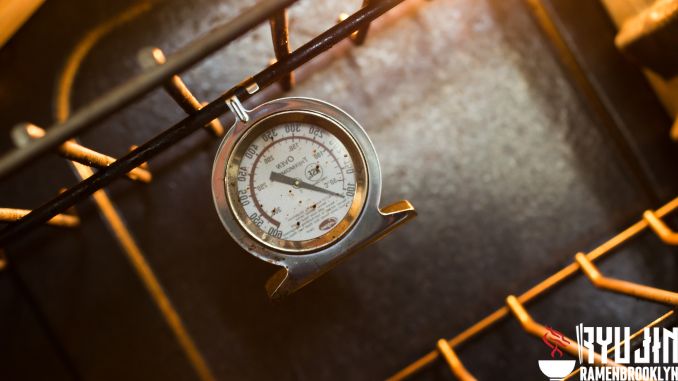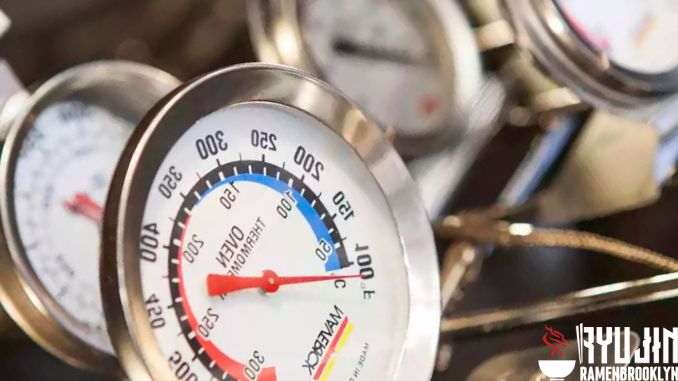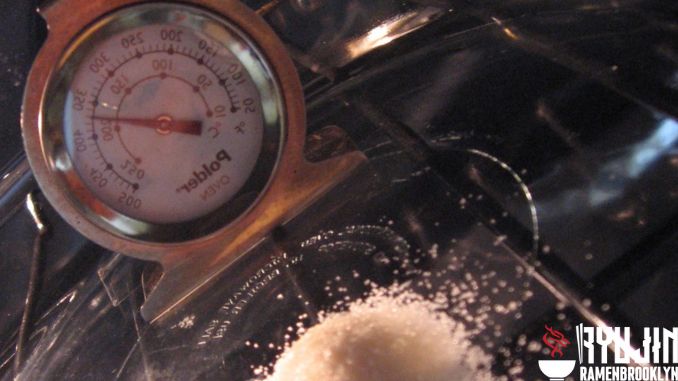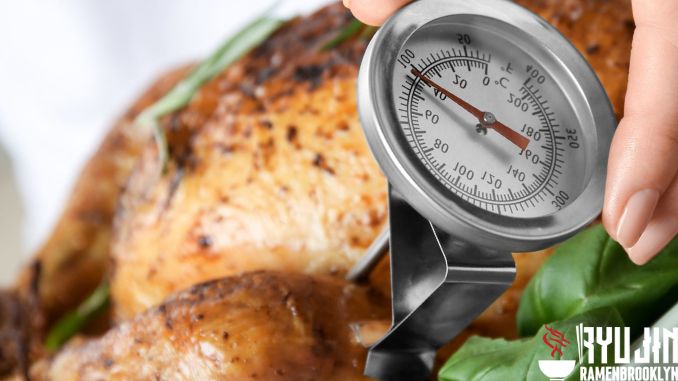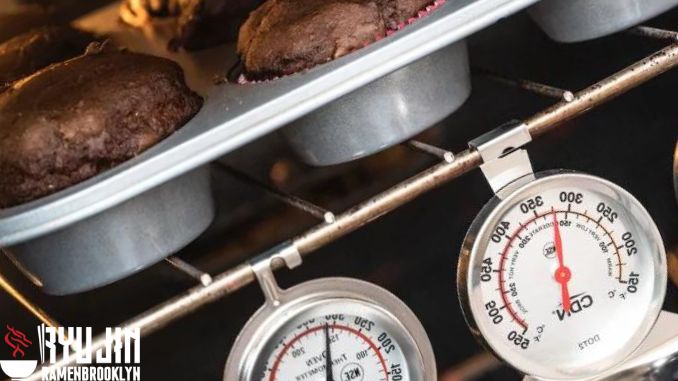How to Use an Oven Thermometer
Like most home cooks, you rely on your oven to help you create delicious meals. But if you’re not using an oven thermometer to ensure that your oven is set at the correct temperature, you’re likely missing out on perfectly cooked food. With an oven thermometer, you can guarantee that your food is cooked evenly and accurately every time.
These thermometers are designed to clip onto the inside of your oven door and provide a real-time reading of the oven’s temperature. This way, you can adjust the settings as needed to ensure your food comes out just the way you want it.
There are a few different types of oven thermometers available, so it’s important to choose the one that best suits your needs. Whether you’re looking for a digital or analog oven thermometer, there’s a model out there that’s perfect for you. So, if you’re looking for a way to improve your cooking skills, investing in an oven thermometer is definitely a step in the right direction!
There’s nothing more frustrating than prepping a delicious dish, only to have it turn out poorly because your oven was off by 50 degrees. That’s why an oven thermometer ensures that your food comes out perfectly every time. Unfortunately, with so many different options on the market, it can be tough to know which one is right for you.
If you want to ensure your food is cooked to perfection, an oven thermometer is a must. In this blog post, we’ll show you how to use an oven thermometer for the best results. We’ll also give you tips on adjusting your oven temperature if it’s not spot-on. So, whether you’re a novice or experienced chef, read on for all the info you need on oven thermometers!
See more: How to check your oven’s temperature
What is Oven Thermometer?
An oven thermometer is a device that measures the temperature inside your oven. It’s important to use an oven thermometer to ensure that your oven is set to the correct temperature. This way, you can avoid overcooking or undercooking your food. Oven thermometers come in digital and analog models, so you can choose the best suits your needs.
The easiest way to know if your oven is running cool or hot? The thermometer! You can hang it on one of those racks and get an accurate reading from inside. Maybe even pair up with some other kitchen tools like fruit knives so you always have them nearby when making dessert after dinner party guests leave without taking home any leftovers (we all know how guilty we feel about this).
An oven thermometer is a kitchen gadget that every home cook should have. It’s an essential tool for ensuring that your food is cooked evenly and to the proper temperature. Oven thermometers come in various styles and price points, so finding one that fits your needs and budget is easy.
When shopping for an oven thermometer, look for one that is oven-safe and has a long probe. Oven-safe models can be left in the oven while it’s on, making them ideal for checking the temperature of food as it cooks. Long probes make it easy to check the temperature of the meat without having to remove it from the oven.
Be sure to calibrate your oven thermometer before using it. This will ensure that it is accurate. To calibrate an oven thermometer, place it in the oven and turn on the oven to its highest setting. Allow the oven to preheat for 15 minutes, then turn off the oven and let the thermometer cool for 5 minutes. Remove the thermometer from the oven and compare the reading to the oven’s actual temperature. Adjust the oven as necessary to achieve the correct temperature.
Why Use Oven Thermometer?
When I first moved into my apartment, it seemed like a good idea to christen the new oven with baking chocolate chip cookies. Little did I know that this would be an expert move, considering how often they come out in movies or TV shows when someone opens their kitchen! So when mine came out as doughy balls instead of flat circles with neatly cut sides like you see on YouTube tutorials for making perfect misteri (it’s pretty easy if done right), there were Some confused looks from friends who asked what went wrong.
When I tried the recipe again, nothing changed. So then it was time for internet research on what could be causing this problem and why my cookies tasted so bland. Finally, the discovery of my oven’s different temperatures was an epiphany. Luckily, there’s a simple and inexpensive solution to this common problem: an accurate thermometer for the grill or broiler element inside your kitchen range!
It’s frustrating when your oven is wrong. It can be too hot or cold, and there’s nothing you can do about it but wait for the temperature to balance out again- which could take hours! Luckily I found a perfect solution: an affordable Thermometer that will tell me exactly how much heat each corner of my kitchen receives, so we don’t have any more unfortunate accidents occurring because people were burned in their kitchens.
Well, your oven has a built-in thermometer, and you probably don’t want to buy another one just yet. But we all know how accurate they can be: They lie! For example, ovens say that it’s preheated at 350 degrees when in reality, the temperature is 260F below what’s needed for an accurate reading—that could explain why my cookies changed texture after baking them too long or why other recipes call for different times depending on whether there are hot spots inside (a common problem).
You should also have a separate meat thermometer for chicken/turkey since they cook faster than other meats but the same goes with all types of proteins; make sure there isn’t any disparity between what’s being cooked inside (on top) versus outside surfaces like grates etc., this will give an accurate representation about how close together everything was done at once so no surprises arise later down the line.
The most accurate way to tell if your oven is preheating correctly and at what temperature, you must use two different thermometers (the Oven thermometer is available on Amazon for under $10). One for the top rack and another below so as not to have any spot hotter than others in between these spots! I put mine right next to where we’ll be baking our goodies because moving around on those rare occasions can affect how quickly food cooks or bakes off – which means more consistent results overall.
Once you have a thermometer, test your oven by preheating it to a specific temperature. Once this is done, careful consideration of where in or around their cooking area will provide an accurate reading from different spots with varying temperatures before moving on to other tasks like rotating dishes while baking.
If there are hot spots anywhere near these areas, then consider setting them lower than what’s recommended for that recipe unless certain otherwise since overdoing things can cause food not to brown properly due to its heat source being too intense for what’s being cooked on top of it.
When you buy a new appliance, like the one your kitchen needs to cook all those delicious goodies we love so much, there’s always some uncertainty about how it will work in terms of performance and durability – especially when they come with such a high price tag!
However, worries melt away upon learning what types of temperature fluctuations can do damage: from ruining food (for example, by causing warping) as well making surfaces more likely for candidates themselves to fail later down the line due to imperfections caused during production processes.
An oven thermometer is a great way to know how your oven is performing and ensure that it’s within the optimal range for whatever you’re cooking. No more guessing, no more ruined food, and no more worrying about whether or not your oven is up to par!
If you don’t have an oven thermometer, get one! They’re cheap and will save you time, money, and energy in the long run. Not only will your food come out tasting better, but you’ll also be able to avoid any potential accidents related to temperature inconsistency inside ovens.
How to Use an Oven Thermometer
If you are not able to use an oven thermometer, it means that your cooking skills need some work. So you might as well get professional help before buying one of these devices because they can be tricky for beginners!
Put Your Thermometer inside Your Oven
Place your thermometer in the oven before placing food on the same rack. This ensures an accurate reading for temperature fluctuations and changes due to cooking methods such as broiling or baking that could affect them drastically!
Place your thermometer in the oven before placing any food on it to ensure an accurate reading. Place it near where you plan on putting all other cookware and appliances so that its readings are comparable with those taken from other surfaces around the clubhouse kitchen.
Check the oven thermometer regularly to make sure that it is working properly. Replace the batteries if necessary.
You should also calibrate your oven thermometer periodically to ensure accuracy. To calibrate your oven thermometer, place it in a pot of water for three minutes. Then, check the thermometer against a known accurate reference, such as a candy thermometer. Next, adjust the oven thermometer accordingly.
Set Your Oven’s Temperature
After you have placed your thermometer inside the oven, go ahead and set the cooking temperatures. Ensure no one item is on top of another so as not to obstruct any airflow through it or damage its sensors with constant weight from toppings like heavy dishes above them during preheating periods; never leave anything touching directly against an exposed surface (like metal) without protection-gloves!
For lower-burning meals like chicken breasts or fish fillets that require less heat but still need an accurate reading on their innermost core temp., use either 350°F/176 °C or 300°F for a medium rare steak, respectively, depending upon what kind of meat it’s being used in order not overpowering flavors from charring.
If you’re looking for a more well-done meal, aim for an oven temperature between 425-450°F/218-232 °C; this will help ensure that your food is cooked all the way through without being burnt on the outside.
Use the Right Oven Rack
For best results, use the middle rack in the oven when cooking with an oven thermometer. This will give you the most accurate reading because it’s closer to the heat source and not as affected by drafts from door openings or other factors like heat rising.
If you have multiple racks in the oven, use them correctly, so there’s plenty of space between each item. This allows hot air to circulate evenly around all food items, ensuring even cooking.
Wait and Preheat
Once your desired temperature has been set, wait until the preheating process is complete before opening up that oven. It will take about 10 minutes to get hot in there! When you check on progress after the 20-30 minute mark, then maybe find out both thermometers read differently from what they did at startup.
This isn’t always true but often happens when metal objects like pots or pans are left inside during cooking time; sometimes, even clothes can cause interference because all those different materials absorb radiant heat differently.
If this occurs, don’t fret! The oven is still functional, and cooking can continue as normal; it’s just important to keep an eye on things so that food doesn’t get overcooked or burnt.
Wait for a Little Longer
Sometimes the ovens can be off a bit when it comes to a temperature reading. If this is happening and your food could potentially overcook, don’t worry! Just give them some more time so everything will cook perfectly as desired.
Place Your Meal in The Oven
Once your oven is preheated, and the timer goes off, it’s time to start cooking! Ensure all food items are placed in the oven on the correct racks before closing the door.
If you’re using multiple trays or baking sheets, try to stagger them so that each one gets equal heat. This will help to ensure even cooking and avoid any hotspots.
Once everything is in the oven, close the door quickly so as not to maintain a consistent temperature throughout the cooking process.
Check on Your Food Regularly
It’s important to check on your food regularly while it’s cooking in the oven. This helps ensure that everything is progressing as it should and prevents potential accidents.
If something isn’t cooking evenly, you can rotate or move items around, so they cook more evenly.
Rest assured that your oven is working properly and that your food is cooking at the correct temperature by using an oven thermometer! These devices are essential for any cook, beginner, or experienced because they take the guesswork out of oven temperature regulation. In addition, oven thermometers are relatively inexpensive and can be found at most kitchenware stores.
See more: How to Steam Clean Oven
Some Tips for Use Oven Thermometer
Read the Instructions
Oven thermometers come with specific instructions on how to use them, so make sure you read these before inserting the device into an oven. Most importantly, note down any temperature calibrations that need to be carried out! This will ensure accuracy from the get-go.
Choose the Right Location
The oven thermometer should be placed in the oven so that its sensor is not touching any walls, metal racks, or other heat-conductive surfaces. Place it as close to the center of the oven cavity as possible without coming into contact with food or anything else inside. If unsure, ask the manufacturer where to position the oven thermometer within your model.
Use Protective Gear
Wearing oven mitts or gloves is always a good idea when handling oven thermometers, as they can get quite hot. Make sure to grab the oven thermometer by its handle or case, not the exposed sensor end!
Some oven thermometers have a clip that can be attached to an oven rack. If yours has this feature, use it to keep the oven thermometer in place while food bakes.
Be Careful of Splattering Foods
Be careful of splattering foods, and be ready to clean up any mess in your oven. Ovens are usually pretty temperature-proof, but when you open the door, there may still end up being some residue on top, which could scratch or damage the thermometer sensor if not cleaned properly with a cloth/towel before checking progress; use these shields while opening, so nothing gets spilled onto it!
Keep an Eye on Thermometer’s Display
Ovens can fluctuate in temperature, so it’s important to keep an eye on the oven thermometer’s display. If the oven is running hotter or cooler than what you set it at, make necessary adjustments accordingly.
If the oven thermometer doesn’t have a display, check on food frequently to ensure it’s cooking evenly and not burning in any spots!
Wait for Food to Finish Cooking
Don’t take the oven thermometer out until the food is done cooking! This will give you the most accurate reading of internal temperature, which is what you’re ultimately looking for.
Monitor the Temperature While Cooking
Check the oven thermometer periodically throughout cooking to make sure that it is working properly. Replace the batteries if necessary. You should also calibrate your oven thermometer periodically to ensure accuracy. To calibrate your oven thermometer, place it in a pot of water for three minutes. Then, check the thermometer against a known accurate reference, such as a candy thermometer. Then, adjust the oven thermometer accordingly.
It’s also important to monitor the food itself as it cooks. For example, use a meat thermometer to check the internal temperature of the food to ensure that it is cooked properly.
Be Careful Not to Open Your Oven Door Too Much
The oven is a tough and loving place but also very sensitive. Be careful with how you open your door because if too much heat leaks out, then the temperature reading will be off!
You should take readings by looking through an opening in this area or use remote thermometers that can withstand high temperatures without getting burned up – which means more accurate information about what’s going on inside there (and less worry).
Move The Thermometer around to Various Spots in Your Oven
When checking for an accurate oven temperature, it is important to move the thermometer around and try different spots to see if there are any hot or cold areas. This will ensure you get an accurate reading of what’s happening inside!
Oven thermometers are fairly simple devices, but you still need to know some things to use one correctly. By following the tips above, you can be sure that your oven thermometer always provides accurate readings.
Benefits of Having an Oven Thermometer
It helps to bake things more evenly.
With the help of an oven thermometer, you will know which parts are the hottest and best for cooking your food.
Suppose there is a lot on one pan or sheet at once. In that case, it can be difficult to distribute heat evenly throughout all areas so that every part gets cooked properly without burning anything prior – this could result in wasted time if not done correctly! It’s important when using any type/size dish because each ingredient cooks differently depending on its size. However, even then, some foods should still require flipping during baking due to how high temperatures vary within an oven.
Batteries will last longer.
An oven thermometer can help you to save money and energy by using less electricity. However, if the oven is not set at the correct temperature, it will use more power than necessary.
This means that your oven will not only be working less efficiently but also costing you more money on your energy bill! A good oven thermometer will help to make sure that your oven is always operating at peak efficiency, saving you both time and money.
It sets your oven to the exact temperature.
Precision is key when it comes to cooking. For example, if you are using an oven that’s 25ºF (4°C) off from what your recipe calls for, then this could lead not only to under or over-baking foods like soufflés and popovers but also make them come out tough as well!
The same goes with fish; they need precise temperatures, so one degree can mean ruin altogether—especially since meatier cuts typically require higher heat than lighter ones to achieve tenderness without burning apart before our eyes.
An oven thermometer can take the guesswork out of temperature setting and help you to achieve consistent results every time.
It helps to maintain the desired temperature.
Monitoring the temperature in your oven is essential for success! You can keep an accurate account by monitoring it with a thermometer while cooking or baking. Then, if something goes wrong, you’ll be able to fix it immediately and save yourself from ruined food products.
It prevents overbaking/cooking.
Ovens are meant to be used at the right temperature. If you put something in an oven when it’s too hot, it will always seem like a risk that they’ll overcook or undercook their meal due to how quickly heat flies through air changes per hour (including things like bread). So make sure you set it correctly before using it so as not to have these problems!
An oven’s components will wear out over time.
The longer you use your oven, the less accurate it becomes.
A lot goes into heating and cooling an entire kitchen: cookware, dishes, the refrigerators-to name just some!
And when we say “a lot,” that means every single thing inside is working hard to keep things running smoothly for all these parts need regular maintenance, too, or they might start smoking from neglecting their basic functions such as maintaining humidity levels within normal limits, so food doesn’t spoil faster than expected.
One oven thermometer can make all the difference by helping to ensure that your oven is running at its best, no matter how old.
It’s important to have an oven thermometer because it provides many benefits, including even baking, longer battery life, setting your oven to the exact temperature, and preventing overbaking or cooking. In addition, an oven thermometer is a small investment that can save you time, money, and frustration in the long run!
FAQs
Why Can Oven Thermometers Improve Your Baking?
Oven thermometers can improve your baking by ensuring that the oven is preheated to the correct temperature. This will help to ensure that cookies are baked correctly and that cakes do not overcook.
Monitoring your oven’s temperature can help you get better results when cooking. For instance, if mine is 25°F cooler than what’s listed on a recipe, then I adjust for each dish depending on how warm or cool it needs to be cooked!
The key to a perfect cookie is the temperature of your oven. If you’re following an old-fashioned recipe that tells you to bake snickerdoodles at 350°F, simply preheat it to 375 degrees Fahrenheit instead and see how much better they turn out!
I love leaving my thermometer in there while baking because it’s so simple – plus, I know this will help me feel more confident. If we both use our appliances efficiently, those little changes can add up over time.
What are the Different Types of Oven Thermometers?
There are two main types of oven thermometers: Dial/glass bulb (analog thermometers) and Digital (Instant-read thermometers).
Dial and glass bulbs (analog thermometers) are both types of heat-measure devices that function in a similar way. A dial face indicates the temperatures on an assigned chart, while bulbs display their information via colored liquids like mercury or alcohol for health reasons. However, they can be difficult to read depending upon your position within any given oven cavity without peering through doors too closely. This might not always work out better than trying other options first!
Digital (Instant-read thermometers) – Instead of giving you the temperature reading inside your oven, these digital gadgets display it on their own. They’re inserted into food and then read by a gauge at either end, which accurately assesses how hot or cold things are getting within that particular slice/slab! Most models aren’t meant to last long periods in direct sunlight, so keep them away from bright lights if possible.
What is the Most Accurate Oven Thermometer?
The most accurate oven thermometer is a digital oven thermometer. Digital oven thermometers are more accurate than analog ones because they use sensors to measure the temperature inside the oven.
Analog oven thermometers are less accurate because they use a glass bulb filled with mercury or alcohol to measure the temperature inside the oven. The liquid in the bulb expands as the temperature inside the oven increases and contracts as the temperature decreases. Therefore, it is difficult to get an accurate reading from an analog oven thermometer.
Digital oven thermometers are more expensive than analog ones, but they are worth the investment if you want to ensure that your food is cooked evenly and correctly.
When shopping for a digital oven thermometer, look for one with a large display that is easy to read. You should also look for an oven thermometer with a long probe to easily insert it into the oven.
Most digital oven thermometers range from -50 to 300 degrees Celsius (-58 to 572 degrees Fahrenheit). Look for an oven thermometer with a wide range so you can use it in different ovens.
What is the Ideal Temperature for Baking?
The ideal temperature for baking is between 325-350 degrees Fahrenheit. This range will ensure that your food is cooked evenly without being overcooked or undercooked.
When using an oven thermometer, it is important to place it in the center of the oven to get an accurate reading. You should also check the oven thermometer regularly to ensure that the oven is maintaining the correct temperature.
If your oven is not maintaining the correct temperature, you may need to adjust the thermostat. Adjusting the oven thermostat is a simple process that can be done by following the instructions in your oven’s owner’s manual.
If you have an oven with a digital display, you can also use the oven’s self-cleaning cycle to clean the oven thermometer. Simply place the oven thermometer in the oven and run the self-cleaning cycle according to the manufacturer’s instructions.
An oven thermometer is a great way to ensure that your food is cooked evenly and correctly. It is also good to save energy by ensuring that your oven is not set too high or too low. So, be sure to use an oven thermometer the next time you bake!
See more: Can I Put Glass in The Oven?
Final Thought
In conclusion, the most accurate oven thermometer is a digital oven thermometer. Analog oven thermometers are less accurate because they use a glass bulb filled with mercury or alcohol to measure the temperature inside the oven. Digital oven thermometers are more accurate because they use sensors to measure the temperature inside the oven.
Most digital oven thermometers range from -50 to 300 degrees Celsius (-58 to 572 degrees Fahrenheit). The ideal temperature for baking is between 325-350 degrees Fahrenheit. When using an oven thermometer, it is important to place it in the center of the oven to get an accurate reading.
You should also check the oven thermometer regularly to ensure that the oven is maintaining the correct temperature. If your oven is not maintaining the correct temperature, you may need to adjust the thermostat. Adjusting the oven thermostat is a simple process that can be done by following the instructions in your oven’s owner’s manual.
If you have an oven with a digital display, you can also use the oven’s self-cleaning cycle to clean the oven thermometer. Simply place the oven thermometer in the oven and run the self-cleaning cycle according to the manufacturer’s instructions.
An oven thermometer is a great way to ensure that your food is cooked evenly and correctly. It is also good to save energy by ensuring that your oven is not set too high or too low. So, be sure to use an oven thermometer the next time you bake!
Now you have it, how to use an oven thermometer! Be sure to use an oven thermometer the next time you bake! Not only will it help ensure your food is cooked evenly and correctly, but it will also help save energy. So, don’t wait any longer; get yourself an oven thermometer today! Also, don’t forget to check out our other topic to know more useful information.
Anthony Michelin (March 26, 1960) is the CEO of Ryujinramenbrooklyn.com – is an expert in finding specialized equipment to assist in the Bar & Kitchen sector. With over 40 years of focus on finding the simplest recipes on the most suitable cookware to create the most delicious meals, I believe it will help you.
